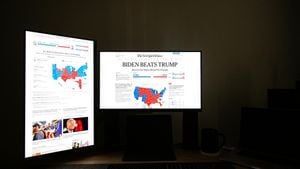Bridget Phillipson, the newly appointed Education Secretary, is making waves as she addresses "baked-in" inequalities engendered by previous Conservative governments.
She highlights significant disparities, especially between the educational outcomes of students from state and private schools, and those from different regions across England.
On the threshold of A-level results day, which falls on Thursday, these disparities are coming to the forefront once again.
According to Phillipson, far too many young people, particularly those from less affluent backgrounds, are living in poverty, which complicates their access to higher education.
She points out the pressing societal issues contributing to these inequalities as many schools struggle to cope under mounting pressures.
The stats are stark: last year, students from comprehensive schools were significantly less likely to attain the coveted top grades compared to their independent school counterparts, continuing patterns seen since pre-pandemic times.
For clarity, last summer saw only 22% of A-Level entries from the North East achieving the top grades, compared to 30% from the more prosperous south-east of England.
Phillipson underscored her desire to reverse these inequalities, stating, "I am determined to make sure all young people, whatever their background, have the chance to progress and succeed".
Her confidence shines through, yet she acknowledges the complex nature of the task, underscoring the need for concerted effort to tackle poverty rates affecting children's education.
Particularly noteworthy is the stark difference in university applications; as of June 30 of this year, only 33.4% of 18-year-olds from the North East applied to universities, compared to over 59% from London.
Phillipson's commitment to tackling regional disparities involves everything from enhancing teacher training to ensuring schools have the necessary resources.
She pointedly notes, "The realities children face outside the classroom significantly impact their educational experience and outcomes".
Recent campaigns led by the Labour party also propose imposing VAT on private school fees, aiming to boost funding for state education.
With the Labour government focused on educational equity, she aims to bridge the gap, ensuring funding and resources are directed where they are most needed.
Shadow education secretary Damian Hinds, from the opposite side of the aisle, has countered these claims by declaring, "Our record speaks for itself", showcasing improvements under Conservative leadership.
Despite political differences, there is agreement on the need to support students better.
Experts also echo the sentiment, with many emphasizing the role of financial pressures and the concerning rhetoric surrounding higher education since the pandemic.
These pressures may deter students from applying to university altogether, changing the route they take after secondary school.
Phillipson's approach—focused on widening access to university education—is reinforced by Ucas chief Jo Saxton, who’s championing improvement across the board.
Saxton remarked, "I want to see application rates among 18-year-olds even out across the country", indicating the centrality of equity as she guides policy and practice at the Ucas level.
This year’s examination results would ideally reveal progress, but uncertainties loom large over the potential impact of socio-economic disadvantages.
Students eagerly await their results as they stand now at the crossroads of their futures—whether to pursue higher education or seek alternative opportunities.
Phillipson reflects this concern and aims for those opportunities to be equally accessible for all, irrespective of socio-economic background.
Sir Ian Bauckham, the head of Ofqual, has expressed his growing concern for disparities within the educational system, emphasizing the need for consistent assessment processes.
Bauckham stated, "It's unacceptable we have these gaps, whether they're regional or disadvantage-related; we must prioritize closing them".
Such statements resonate, especially as the stark realities of disadvantage appear across the board.
Phillipson concludes with determination, reaffirming her commitment to reform the system, making higher education not just attainable but appealing for all students.
With each A-level results day marking the potential pivot point for thousands, the intense scrutiny and subsequent discussions serve only to amplify the importance of equitable education across the board.
How this narrative will evolve, as practice meets policy post-results day, remains to be seen.
The underlying question remains: just how effective can the new initiatives be at tackling these long-standing inequities?



